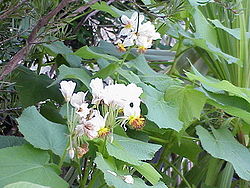Sparmannia africana
| Habit | tree
| |
|---|---|---|
| Height: | ⇕ | 20 ft"ft" can not be assigned to a declared number type with value 20. |
| Width: | ⇔ | 10 ft"ft" can not be assigned to a declared number type with value 10. |
| Lifespan: | ⌛ | perennial |
| Bloom: | ❀ | early spring, mid spring, late spring, early summer, mid summer, late summer |
| Exposure: | ☼ | sun |
|---|---|---|
| Features: | ✓ | flowers |
| USDA Zones: | 9 to 11 | |
| Flower features: | ❀ | white |
|
africana > |
Sparrmannia africana (African hemp, African linden) is an ornamental plant of Sparrmannia genus in the Tiliaceae family, which is native to Africa. Angiosperm Phylogeny Group places the genus within the Malvaceae family.
Read about Sparmannia africana in the Standard Cyclopedia of Horticulture
|
|---|
|
Sparmannia africana, Linn. A large shrub or tree, 10-20 ft. high: lvs. cordate-acuminate, 5-7-angled, unequally toothed, 5-6 in. long, 7-9-ribbed below: fls. white, on many-fld, peduncles: caps. 5-celled. S. Afr.—A useful greenhouse plant. Var. flore-pleno, Hort., is also grown.—S. africana is not common in S. Calif., but is highly esteemed. One specimen, 40 years old, is 12 ft. high and 16 ft. through, and consists of about 50 trunks 1/2 – 4 in. diam. It is literally covered with snowballs of 4 in. diam., the blooms being so heavy that the ends of the branches touch the ground, necessitating severe pruning as soon as blooms were past beauty. No viburnum, hydrangea, or other shrub can compare with it at its blooming season. During the remainder of the year it has the appearance of a clump of basswood suckers, the lvs. being nearly identical in appearance with those of the basswood. It is therefore a dense mass of broad lvs. and looks well anywhere and at any time. This is one of the finest white-fld, shrubs or trees in cult. The double variety is not so desirable as the single. CH
|
Cultivation
Propagation
Pests and diseases
Varieties
Gallery
References
External links
- w:Sparmannia africana. Some of the material on this page may be from Wikipedia, under the Creative Commons license.
- Sparmannia africana QR Code (Size 50, 100, 200, 500)
